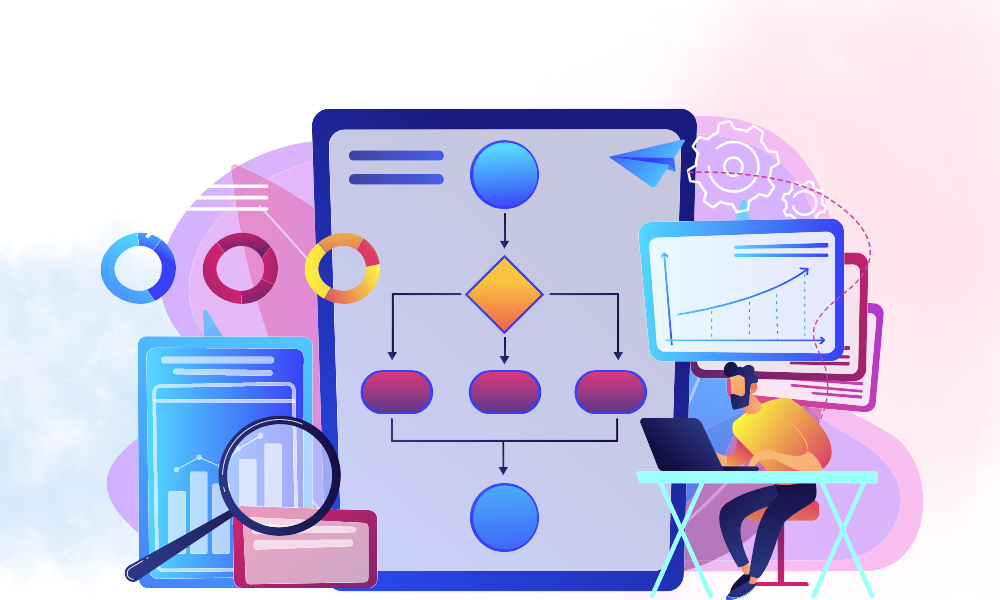What are 6 Steps for Implementing Business Process Management (BPM)
Share:

What are 6 Steps for Implementing Business Process Management (BPM)
Share:

Get to know about
Topics Covered
How to Implement BPM Successfully in Your Organization?
In today’s dynamic business environment, organizations strive to enhance efficiency, optimize operations, and improve overall performance. Business Process Management (BPM) has emerged as a key strategy to achieve these goals by streamlining and optimizing business processes. There are hidden costs associated with operational inefficiency.
This step-by-step guide will walk you through the process of implementing BPM in your organization, helping you harness its full potential for sustained success.
1. Define Objectives and Scope
Defining objectives and scope in Business Process Management (BPM) is crucial for establishing a clear roadmap towards process optimization.
Objectives should be explicit, measurable, and aligned with the organization’s strategic goals, encompassing aims such as
- improved efficiency,
- enhanced customer satisfaction,
- or cost reduction.
Securing executive support is paramount to ensure commitment and resource allocation.
Simultaneously, defining the scope involves:
- Selecting key processes for improvement.
- Setting clear boundaries.
- Specifying what is within and outside the initiative’s focus.
The scope provides a framework for the BPM effort, preventing unnecessary diversions and ensuring a concentrated approach to achieve the defined objectives. This combined clarity of purpose and scope serves as a foundation for a successful BPM implementation, guiding organizations toward meaningful process enhancements and overall business improvement.
Here is an example of Scope and Objectives in Customer Service BPM
Objectives:
The primary objective of a customer service BPM initiative could be to enhance customer satisfaction and operational efficiency. Measurable goals may include:
- Reducing average response times.
- Increasing first-contact resolution rates.
- Improving customer feedback scores within a specified time frame.
This initiative aims to position the company as a customer-centric service provider, ultimately contributing to increased customer loyalty and retention.
Scope:
The scope of this BPM initiative involves in-depth analysis and improvement of specific customer service processes. In-scope processes encompass customer inquiry handling, ticket resolution, and communication protocols. Out-of-scope processes may include broader business strategies unrelated to immediate customer interactions. The integration of BPM tools will focus on enhancing communication channels and automating routine tasks to streamline processes. This clear delineation of objectives and scope ensures a targeted approach, allowing for impactful enhancements in customer service operations while avoiding unnecessary disruptions to unrelated organizational functions.
2. Process Mapping and Analysis
Process mapping is a strategic technique that involves visually representing the sequence of activities within a specific workflow or business process.
The method aims to provide a clear and comprehensive view of how tasks are undertaken, facilitating analysis, optimization, and communication within an organization. Utilizing standardized symbols, various process mapping methods such as flowcharts, swimlane diagrams, and value stream mapping offer diverse perspectives on the flow of activities, decision points, and department interactions.
These visual representations enable teams to identify bottlenecks, redundancies, and areas for improvement, fostering a shared understanding of processes and supporting informed decision-making for continuous enhancement and efficiency.
3. Select BPM Technology
Choosing the right technology approach for Business Process Management (BPM) involves a careful consideration of organizational needs and objectives.
- Traditional BPM application development offers customization but often requires significant time and resources.
- Ready-to-use BPM solutions provide faster implementation but may lack flexibility.
- No-code or low-code platforms bridge the gap, empowering users with varying technical expertise to design and deploy processes quickly. No-Code Development empowers non technical users and these platforms offer a balance between customization and speed, enabling rapid development while allowing for adjustments as business needs evolve.
The choice among these options depends on factors such as complexity, customization requirements, and the organization’s overall IT strategy, emphasizing the importance of aligning BPM technology with specific business goals for optimal efficiency and adaptability.
4. Testing and Debugging
Testing and debugging play pivotal roles in the Business Process Management (BPM) lifecycle, ensuring the reliability and efficiency of implemented processes. In BPM, testing involves verifying that the designed processes meet the specified requirements and operate seamlessly. This includes unit testing of individual process components, integration testing to validate interactions between different processes or systems, and end-to-end testing to assess the entire process flow.
Conversely, debugging focuses on identifying and rectifying errors or issues that arise during testing or actual process execution. It involves thorough analysis, troubleshooting, and modification of process elements to eliminate bugs or bottlenecks. Automated testing tools are often employed to streamline these processes, allowing for quicker identification of issues and facilitating iterative improvements. The iterative nature of testing and debugging is crucial in the dynamic BPM environment, ensuring that processes not only meet initial requirements but also remain adaptable and resilient to changes over time.
5. Training and Change Management
While implementing BPM, training and change management is essential as it navigates the cultural, structural, and procedural adjustments necessary for successful process optimization. This includes communication strategies to articulate the benefits of the new processes, training programs to equip employees with the required skills, and addressing potential resistance to change.
A well-executed change management plan fosters a positive attitude toward BPM initiatives, encourages collaboration, and facilitates a smooth transition to the optimized processes, ultimately maximizing the effectiveness and sustainability of BPM within the organization.
6. Monitor and Optimize
Continuous improvement involves a cyclical process of planning, implementing changes, measuring outcomes, and refining processes based on the results. This iterative approach ensures that organizations not only achieve initial efficiency gains but also remain agile and responsive to evolving challenges and opportunities.
Embracing a culture of continuous improvement within BPM fosters innovation, empowers employees to contribute to process enhancements, and positions the organization to stay competitive in an ever-changing business landscape.
Implementing Business Process Management is a strategic investment that can revolutionize how your organization operates. By following these 7 steps, you can systematically introduce BPM, enhance efficiency, and drive sustainable success. Remember that BPM is not a one-time project but a continuous journey toward excellence and adaptability in an ever-evolving business landscape.
Related Topics
10X efficiency with No-Code BPM
Tailored workflows for all your unique business processes.











